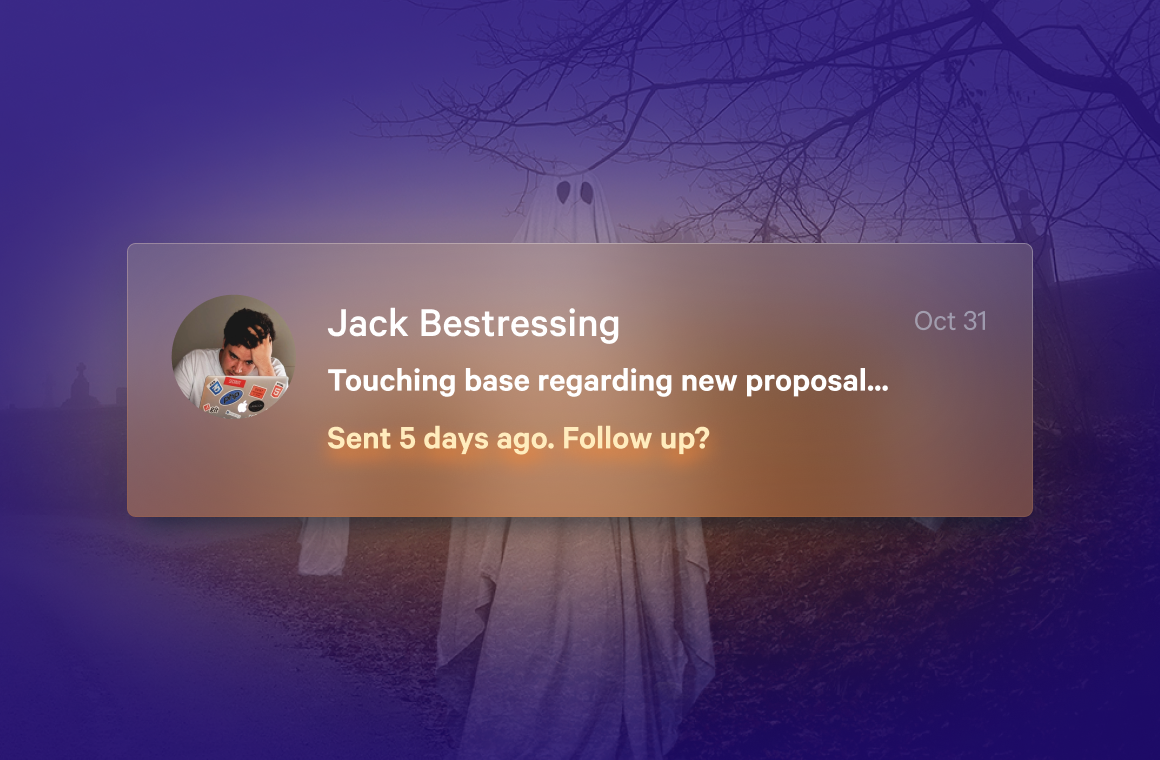Ever spent hours crafting what you thought was the perfect email, only to get tumbleweeds or crickets in response? If you nodded, you're not alone. In the digital age, where email personalization is no longer a luxury but a necessity, sending generic messages just won't cut it.
Imagine being in a room full of people, and someone is speaking in a monotone, addressing nobody in particular. Would you listen? Probably not. The same applies to emails; they're ignored if they don't resonate.
The problem? Many businesses still stick to a one-size-fits-all approach, missing out on the immense benefit of personalized communication. Generic emails are easily dismissed, lost in a sea of daily messages, failing to capture attention or drive action.
It doesn’t have to be that way. With this email marketing strategy and these email personalization techniques, a little effort goes a long way. (And, no, I don’t just mean using the subscriber’s name!)
These email personalization strategies will ensure your emails are not just seen but remembered.
Step 1: Write a captivating subject line
What you write in your email only matters if someone opens it. So, your first goal is getting your recipient to open your email. This is where a captivating subject line comes in. What better way to grab someone’s attention than by using some personalization?
Personalized subject lines should accomplish three things:
- They should spark someone’s curiosity just enough to open the email.
- They should hint at what the email will be about.
- They should stand out from other subject lines in a person’s inbox. These may seem obvious, but hitting all three can be a challenge.
When looking at email subject lines, (even in my own inbox), the most common email subject line I saw used was “{{company_name}} + My Company”. However, unless your company's name describes exactly what your email is about, the recipient has no way of knowing what’s inside. This subject line is so overused and so obviously a sales email that it causes recipients to glaze over it and avoid opening it. So, unless they’re bored or compulsive, they have no reason to open a message with this type of subject line.
If you read five blogs and they all say you should be including emojis, using a buzzword like “free,” or starting your first email with Re: in the subject line don’t do that. These might not be bad ideas by themselves, but if the advice is common enough, they’ll most likely be overused and lose any value they might have had. In fact, Google’s priority inbox tends to filter emails using the words free, discount, etc. into the recipient’s promotions tab, decreasing the likelihood that they’ll open it (or open it in any timely manner).
Because of this, I can’t give you any copy-and-paste ideas, but I can give a few guidelines for your subject lines:
- Standard open rates for cold emails range between 15-25%. That said, the main subject line I’ve been using has hovered around a 60% open rate with over 200 emails sent in total, and I’m sure there’s still room for improvement.
- Vary the length of your subject lines to see what works. The first subject line I found that consistently hit 70% open was just two words long (“{{company_name}}’s proposals”). For reference, research suggests around 41 characters is the optimal length.
- Write the body of your email first. Writing a captivating subject line is easier once you know what your email is about. It also helps you avoid misleading subject lines that may have high open rates but don’t actually relate to your email’s content.
- Always A/B test your subject lines. Split your email list in half and send half the people the message with subject line A and half with subject line B. Compare metrics like open rates, unsubscribed, and click-throughs to see which subject line is performing better. Keep the better-performing subject line and choose another variation to test it against. Continue the process to further optimize your subject line.
- Avoid any common tropes you see frequently used — this will help you stand out in a person’s inbox. If you’re looking for inspiration, take a look at Really Good Emails. This collection of inspiring email content can help you to come up with fresh ideas that are likely to resonate with your target audience.
Remember, most of your work goes into your email messaging. Even if you get an 80% open rate, 20% of your work will be wasted. So relentlessly experiment with your subject lines and drive that number as close to 100% as possible.
Step 2: Prove you are a human
The internet is filled with spammers. Thanks to data aggregation tools, the contact information of any persona you can imagine is available. All you need is an internet connection and $100. That means any decision maker’s inbox you might be reaching out to is likely a nightmare, overflowing with robotic email templates sent out en masse to anyone with a pulse.
Because of this, the first thing you should do when reaching out to someone is prove that you are, in fact, a human. Luckily, this shouldn’t be too difficult since you’re actually a real person.
It comes down to personalization and speaking to them on a professional yet personal level. Generally, most of the information you want can be found on their LinkedIn profile or their website.
What you’re looking for is anything remarkable to comment on. Here are a few things you can look to add to your email marketing personalization:
- A recent blog post they authored or shared
- A common alma mater (That Alumni Association Membership comes in handy!)
- Recent award, recognition, or press mention (e.g., Series A raise)
- Hobbies or interests shared publicly on LinkedIn
- Local events and news
- A mutual LinkedIn connection
- A shared or high-profile customer of theirs
- Name-drop their colleagues — especially those whose success they’re responsible for
- Reviews from their customers.
- How long they’ve been in their role
- Who their competitors are
- What you love about what they do or a positive customer experience
Using video messages within emails is also an easy, fast, and effective way to start a conversation. The highest performing template I’ve created so far (75% open, 11% reply rate) included no text — just a GIF linking to a 1-minute video.
I believe this is because with video, even if you’re reading from the same script in each video, the added elements of tone and body language make it feel much more human and personalized. Video also forces you to say your pitch out loud, which helps to avoid any clunky wording.
The downside to using video exclusively is that it’s not skimmable. Unless someone views the video (and many won’t), they’ll know nothing about what you do or the problem you solve.
Step 3: See if they actually have a problem
You have an awesome product or service, and if you’re like me, you’re probably excited to talk about how awesome it is. However, just because you have a genuinely awesome, life-changing solution, that doesn’t mean the person you’re reaching out to actually needs that solution.
People often launch into their pitch before prodding a possible pain point. This is a misstep. Before you pitch, you must give people a reason to care about your pitch. The best way to do this is by highlighting a struggle you think they’re experiencing. Here’s an example email from Gorgias that does an excellent job at leading with the problem:
A solution is meaningless unless there is a problem. Lead with the problem they’re facing, and then give them the pitch.
Step 4: Position your pitch to pique interest
When you do deliver your pitch you want to communicate in the most concise way possible. Tell your email recipient what you can do for them and how you can impact their role or the broader organization.
I generally find a good pitch includes two components: an emotion and a number. For example, “Qwilr allows you to create beautiful proposals you will be proud to share. You can get a proposal to your prospect 33% faster than other proposal tools.” This way, you’re talking to both the head and the heart, so to speak. This is also a good place to leverage social proof and highlight a customer similar to your target company by sharing a case study.
If you’re lucky enough to have a strong customer base and a marketing team that conducts surveys, let that data inform your pitch. Look at what your customers love about your solution, and the critical pain points they came in with, and lead with that.
As with the subject lines, A/B testing here is critical so you know which positioning works best.
Step 5: Segment your audience
Every company has its own set of challenges, goals, and operating rhythms. Just like individual subscribers, no two businesses are the same. So, when reaching out to potential B2B partners, it's crucial to understand the unique narratives of each business.
A tech startup's needs will vastly differ from those of an eCommerce company or a healthcare provider. Identify the specific challenges and aspirations within each industry. Offer insights, products, or services that align with these nuances.
Segment your email list into like groupings and use these audiences to guide outreach, messaging, and even special offers that may be relevant to each group.
Your marketing software should allow you to track the engagement metrics of your outreach. Check these metrics frequently to ensure you know which companies open your emails but aren’t taking any action and which companies are eagerly taking the next step. Let these patterns guide your follow-ups, offering content or solutions tailored to these specific behaviors and audience segment needs.
Step 6: Leverage data-driven insights
In B2B, it’s not just about sales but forging partnerships. Every interaction with a potential B2B client gives you data that can shape future collaborations.
Did Company X download a whitepaper on cloud solutions last month? That's a cue. Your next email could delve deeper into the world of cloud solutions, offering advanced insights, case studies, or even a demo of your related products and services.
Again, track what is resonating within your email content. If a company frequently engages with content about cybersecurity, it indicates an interest or even a pain point. Respond by detailing how your product or service addresses cybersecurity challenges or offer content that delves deeper into the topic.
Using the insights you glean from any data you collect to determine your next move will help you tailor your follow-up to your audience’s interests and needs based on what they have shown you with their interactions with your emails and content.
Step 7: Include personal details
The personalized experience goes beyond just addressing a stakeholder by their first name; it's about acknowledging the business relationship's history and milestones.
If you previously supplied a company with enterprise software solutions, reference this (or other relevant content) in your next interaction. For example, "We noticed how effectively your team integrated our CRM software last quarter. Considering your growth trajectory, we thought you'd appreciate a demo of our new analytics feature tailored for scalability."
If you know they've recently launched a product or expanded to a new market, use that knowledge. "Congrats on the recent European expansion! Given the unique compliance challenges in that market, our team has some insights that might streamline your operations."
It's all about making businesses feel seen and valued—customer relationships 101. When you acknowledge your shared history, it cements trust and sets the stage for fruitful future engagements.
Step 8: Send emails at the right time
In the B2B world, timing is crucial. It's not just about when they'll read the email, but when they need it.
Did a big tech conference just wrap up? Or perhaps there were significant regulatory changes in their industry? Send your insights or solutions tailored to these developments, positioning your brand as an up-to-date industry insider.
Leverage tools to understand when your B2B clients are most active. Are they engaging more with morning emails or those sent post-business hours? Tailoring your send times based on this data ensures your emails align with their rhythm.
Strategically timed and targeted emails reflect an understanding of your B2B client's operations and their industry's broader pulse. It's not just about being in their inbox but about being there when it matters most.
Step 9: Call to action
I think everyone is familiar with what a good CTA in email copy looks like, so I won’t spend too much time here. With outbound, you typically ask for a call or a referral — someone else at your target company who would be best to connect with.
The general rule here is to make it as easy for people as possible, so it’s good practice to include a direct link to your calendar or any other resource your recipient will need to complete the call to action.
Cold Email Template
After all that theory, here is some practice with a template you can analyze and customize.
Subject: Elevate [Recipient's Company]’s Digital Presence in Q3
Hello [Recipient's First Name],
I hope this message finds you well. I recently came across [Recipient's Company] during my research on industry leaders in [specific sector, e.g., "financial analytics"]. I was knocked out by your recent [specific achievement, e.g., "Q2 report on consumer trends"]!
My name is [Your Name], and I'm with [Your Company]. We specialize in [specific service/product, e.g., "digital content creation tailored for the financial sector"]. Given the rapid shifts in how businesses engage online, I believe there's an opportunity for [Recipient's Company] to shine even further in the digital landscape.
Here’s what we’ve done for companies like yours:
- Assisted [Previous Client's Name] in increasing their online engagement by 25% in just 6 months.
- Revamped [Another Client's Name]'s website, resulting in a 40% increase in organic traffic.
I'd love the chance to chat for 10 minutes and discuss potential strategies that can benefit [Recipient's Company]. Would [specific date and time, e.g., "Wednesday at 2 PM"] work for you?
Thanks for your time, [Recipient's First Name]. I am looking forward to potentially collaborating and contributing to your ongoing success.
Best,
[Your Name]
[Your Position]
[Your Contact Information]
It may look a little cheesy- hypotheticals always do, compared to the specifics of real life- but here is why this would be an effective email:
- Personalized Approach: It references specific achievements of the recipient's company, showing that the sender has done their homework.
- Clear Value Proposition: The email highlights past successes with similar companies, providing a tangible glimpse of potential results.
- Brevity: While the email is concise, it still conveys all the necessary information, respecting the recipient's time.
- Warm and Professional Tone: The tone strikes a balance between being professional and approachable, making the recipient more likely to engage.
- Clear Call-to-Action: By suggesting a specific date and time for a meeting, the email makes it easy for the recipient to say yes or propose an alternative.
- Subject Line: The subject is benefit-driven and focused on the recipient's potential gain, encouraging them to open the email.
This cold email works because it demonstrates value upfront, establishes credibility, and makes the recipient's next steps clear and easy to follow.
FAQs
How often should I personalize emails for optimal engagement?
Personalized email marketing campaigns should be a consistent effort. However, the depth of personalization may vary. Basic personal touches like using the recipient's name should be standard. Deeper personalization, like referencing specific events or developments, should be utilized when the context and data are available.
Isn't it time-consuming to craft personalized emails for every lead?
While it requires more effort than sending generic blasts, the return on investment in customer engagement and conversions is significantly higher. And with the right tools and strategies in place, it is a marketing strategy that can be scaled efficiently.
Can over-personalization come across as creepy or invasive?
Yes, being too personal too quickly can come off as creepy or invasive. That’s why you must strike the right balance. Use the public customer data- including information you find on their landing page, social media, etc.- or that’s been previously provided by the recipient. Avoid referencing information that they haven't shared with you directly or isn't publicly associated with them.
How do I measure the success of my personalized email campaigns?
Engagement metrics like open rates, click-through rates, and response rates can give you an immediate sense of how well your emails resonate. In the long run, however, conversion rates and the quality of leads generated will be the true indicators of success.
Are there tools that can aid in email personalization?
Loads! The best email marketing platforms offer features and integrations that allow for segmented email lists (including different demographics), dynamic content insertion, real-time insights, triggered email automation, and marketing automation- making personalization strategies more streamlined and scalable.
Continued optimization combined with email personalization drives results
While generic email blasts are lower effort, the ROI on personalized emails is more than worth the effort and attention. To avoid watching your growing email list rapidly shrink as people unsubscribe, make sure your email content is personal, relevant, and adding value instead of just adding noise.
If you’re looking to add personalized, professional-looking sales collateral to your email messages, look no further than Qwilr. Our proposal templates can help you put together polished and personalized messaging in minutes. And the better news? They’re all available with our free 14-day trial.
About the author

Marissa Taffer|Founder & President of M. Taffer Consulting
Marissa Taffer is the Founder & President of M. Taffer Consulting. She brings over 15 years of sales and marketing experience across various industries to a broad range of clients.


